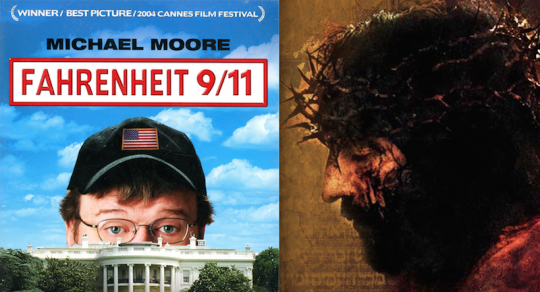Armond White has an essay in the latest issue of National Review in which he argues that 2004—the year the media trashed Mel Gibson’s Passion of the Christ and the film establishment lavished praise on Michael Moore’s Fahrenheit 9/11—is "The Year the Culture Broke." Here’s White:
Attacks on [the religious aspects of Gibson’s film] formed a pattern of intolerance from media normally expected to be cautious and respectful (even when not fair). Journalistic ethics were trashed, and formerly assumed rules of public dialogue and cautious conduct fell by the wayside. Even worse, reviewers’ hostility had a disturbing air of anti-religious bias; their snide rejections incited a mean collective contempt that deepened schisms in our ongoing culture war. ...
Although Fahrenheit 9/11 doesn’t have the probity or imagination of such classic documentaries as Nanook of the North, Let There Be Light, or Fires Were Started, that Palme d’Or conferred prestige on Moore’s agitprop and bolstered the Left’s claim to righteousness. TV host Roger Ebert further sanctioned Moore’s folly, saying, "This film has a point of view, and that’s okay." Ebert’s praise gave naïve viewers a distorted notion of what counts as truth in a documentary. …
Here is where the culture broke — by breaking tenets of decency. After the media’s misrepresentation of Gibson’s faith and after Moore’s propaganda, all rationality and taste were rendered irrelevant. New low standards were set in place and have held sway over the past pitiful ten years. Hollywood’s one-sided approach to art, religion, and politics initiated superficial and thoughtless responses to Americans’ multifaceted personal and political views. From 2004 on, even "entertainment" movies were made and received with deleterious political and moral bias.
As I noted on Twitter, there’s a fair amount of cultural amnesia at work in White’s piece. (Over at Reason, Jesse Walker covers* that ground fairly well; David Frum’s book on the 1970s is also essential reading on the issue of our broken culture.) The nation has undoubtedly been divided for a long time and at certain points the divide has been much deeper. That being said, White’s still making an interesting point. 2004 might not be the year the culture broke. But it could be the year the culture bifurcated.
White is undoubtedly right that Moore’s work gave permission to documentarians—never a particularly conservative bunch—to let their freak flag fly. Compare the Oscar nominees for best feature documentary in 1996 to 2006. 1996’s nominees were: When We Were Kings (a boxing documentary); The Line King (about an illustrator); Mandela (guess); Suzanne Farrell: An Elusive Muse (about a ballet star); and Tell the Truth and Run (about a journalist). And here’s the lineup a decade later: An Inconvenient Truth (Al Gore’s PowerPoint presentation on global warming); Deliver Us From Evil (about the predations of the Catholic Church); Iraq in Fragments (guess); Jesus Camp (ew, Christians); and My Country, My Country (a documentary on Iraq by Laura Poitras, of Edward Snowden fame).
Something changed. And that change has an interesting echo on the right: The rise of the religious film. If Michael Moore’s documentary kicked off a golden age of agitprop, Gibson’s retelling of the death and resurrection of Christ kicked off a golden age of religioprop. We’ve seen an explosion of films with Christian themes in recent years; in 2014 alone we saw Heaven is for Real, God’s Not Dead, and Son of God do shocking box office numbers, driven almost entirely by good mentions in the religious press and outings from church groups. I’m guessing a Venn Diagram of those who regularly watch agitprop and religioprop would have an overlap of about three people.
What White is getting at, a bit obliquely, is the fracturing of our culture—the explosion of options online, the exponential growth of television channels to watch, the endless ocean of books one mouse click away, the microtargeting of movie audiences—and the way that has manifested itself on the left and right wings of moviegoing audiences. Leftist secularists have their own programming and look on films such as Heaven is for Real with suspicion if not outright derision; religious audiences do the same to critically overhyped agitprop of the type produced by Michael Moore and his progeny.
It’s easier than ever to surround ourselves with cultural products that reinforce our worldview. This may not be the sign of a broken culture. But it is the sign of a fractured one.
*One thing I would quibble with Walker on: the fact that Gibson and Moore appreciated each other as artists isn’t terribly surprising, nor is the fact that Gibson approved of Moore’s tendentious anti-war film, given what we now know of Gibson’s worldview. That doesn’t lessen the fact that Fahrenheit 9/11 was a huge success in deep-blue cities like New York and San Fran while underwhelming in redder areas. Similarly, Passion of the Christ was a big hit because church groups made it their mission to pump up the box office. It’s by no means absurd to suggest one is a blue state totem, the other red.
